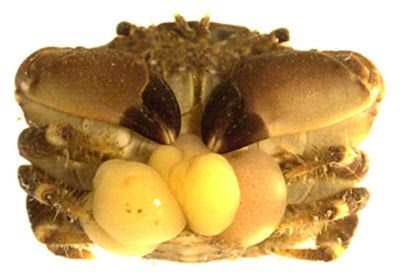 |
Who’s an adorable little Cthulian horror? |
But just like any spawn of an Elder-God, there comes a time when they just want to settle down. So the females search for the perfect home to eventually raise their own brood of Lovecraftian abominations. But not any home will do, no, the females are very picky about where they make settle. In this case it is an unsuspecting crab.
 |
| Hello mister crab! Doesn’t he look happy? |
It is now that Succulina swims underneath our happy little crab there and using a needle on the rear of its body injects a cluster of cells into the crab and simply discards with the remaining 90% of its body. As if this were not disturbing enough, the protoplasmic blob that is left over begins growing tendrils throughout the body, including the brain and around the eye stalks. It uses these nightmarish appendages to leach nutrients from our once happy crab. Eventually a cancerous blob begins to grow on the underside of our once care-free crab. Known as the externa, this is the egg sack of our once terrifying yet oddly cute free-swimming friend.
 |
Holy Hell! What did you do to Mister Crab?! |
But the cancerous abomination and internal leech tentacles are not the worst part. Yes, it really can get worse. Remember when I said they grow all the way to the brain? Well there is a very specific reason for this. This is because it needs to take over the mind of its unwitting host. It stops the crab from molting (as this would cause it to shed the externa) and just grow and grow. It changes its habits so all it does is eat and carefully groom the cancer pouring out of its carapace like it is its own egg sack. It doesn’t even matter if it was a female crab that was infected either. Sacculina will just change the hormone levels of a male crab so that its underside grows wider like a female (all the better for the externa to grow). It also effectively sterilizes the crab so that it never has any interest in any other crab. It just eats and grooms the progeny of The Blob. When the eggs are finally ready to hatch, Sacculina takes further control of the crab, forcing it to walk into shallow water and shake open the externa so that all the little larvae may swim free in a horrifying imitation of the crab’s own ritual of releasing its eggs. This completes Sacculina’s life cycle with thousands of tiny larvae off to find crabs of their own to infect. And just to make matters just a tiny bit worse, Sacculina is actually just a specialized form of barnacle. Try looking at those ubiquitous shore side critters again.
------------------------------
References:
Zimmer, Carl. Parasite Rex

2 comments:
The horror. What happens to the crab once the larvae are released? Is the crab too weakened from the parasitic infestation to continue living?
Actually it is not uncommon for a Sacculina infected crab to live long enough to nuture multiple broods of the parasite. While the infestation is extensive, Sacculina only takes away as much nutrients as it needs for its own survival and the growth of its spawn. Since the once happy crab now spends all of its time eating and grooming and not much else, there is plenty of energy to go between the two.
This is similar to how snails infected by other sterilizing parasites grow far larger than their 'clean' counterparts. It really is amazing how much energy animals devote to reproduction.
Post a Comment